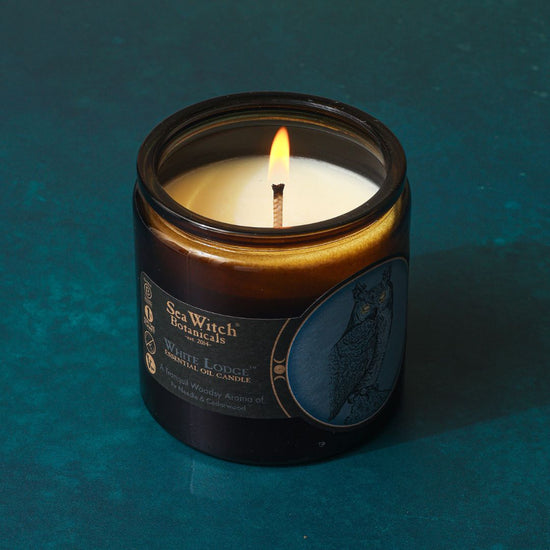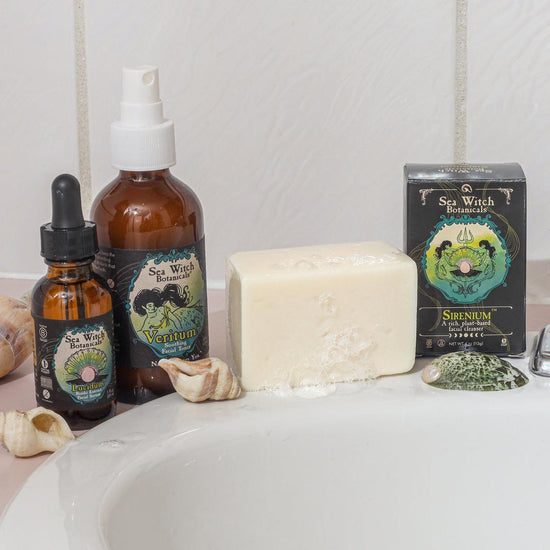Incense - Benefits, Use, History & Health

Table of Contents
- What is Incense?
- Popular Forms of Incense
- The History & Benefits of Burning Incense
- What Does Burning Incense Do, Spiritually?
- Burning Incense Properly
- Incense & Health
- Is Incense Bad for You?
- Synthetic vs. Natural Fragrances in Incense
- Burning Incense with Essential Oils
- Benefits of Burning Incense
What is Incense?
Incense has many forms, but in the simplest definition, it’s any plant matter which is burned for its aromatic or spiritual properties. Most people are familiar with the Indian agarbatti sticks, or small cones, but even raw plant material like palo santo wood chips or sweetgrass can be considered incense.
Popular forms of incense
- Sticks
- Spirals or Coils
- Cones
- Loose powders
- Raw plant materials
The History & Benefits of Burning Incense
The act of burning incense has been an important ritual since ancient times. Believed to have originated in Egypt in the time of the Old Kingdom, it was once used by priests for fumigating tombs. Incense has a long history of being used in conjunction with ceremonies, rituals, and spiritual and religious occasions.
Incense burning was discovered in India and Southern Asia as early as 3300 BC. Used alongside worship and prayer, it was believed that burning incense could ward off evil spirits while purifying the surroundings.
Over 2,000 years ago, the trade of spices and incense played a significant economic role between the east and west. In those days, the Middle Eastern Incense Route wound its way through the Middle East to the Mediteranean region, where it was popularized by the Roman Empire. It’s been estimated that 3,000 tons of incense traveled this route each year.
What does incense do, spiritually?
The spiritual purposes of burning incense can vary based on the religious ceremony or intention during its use. Catholic churches may burn frankincense to connect its community to the legacy of their founding patron. Palo santo wood was burned during the height of the Incas to clear bad energy and has been more recently adopted by a growing community of energy-aware people (however the question remains whether we should be).
Having a background in aromatherapy, our founder chose to develop scents based on their physiological impacts, which can then be used to aid in meditation and mood enhancement.
Today, burning incense is synonymous with the practices of several diverse religions, including Catholicism, Buddhism, and Hinduism, but its use goes beyond the spiritual, as it is now commonly used in yoga studios, wellness offices, and our own homes. Green Witchcraft often employs burning incense sticks or loose herbs in a dish.
Burning Incense
While burning incense may vary wildly in form, the essential function of it is to burn over time. Use a lighter, match, or other open flame to ignite the smallest point of the incense. Allow it to catch fire, then quickly blow out the flame. What remains should be a smoldering ember which will slowly burn and release its aromatic compounds.
Place the incense in a dish specifically designed for incense, or a bowl of sand. You can snuff out the ember by smudging on a hard surface, but it’s generally expected to just let it burn out. Always keep embers and open flame away from any flammable materials such as curtains, paper, or dry herbs.

Incense & Health
Is incense bad for you?
Sitting around a campfire is as core to human behavior as walking on two legs and making abstract connections. Burning incense takes that activity down to a smaller level. There have been a few studies around incense smoke and the impact on human health. Some of these studies could be considered biased (paid for by tobacco companies). The quality of materials can vary, so it’s important to buy incense that lists its ingredients. Incense smoke can be detrimental to health in concentrated amounts, so it is advised that you have plenty of airflow in any room with incense and that you never leave it burning unattended or around drapery in case of a fire.
One insidious type of ingredient continues to creep into the incense market, making expensive resins appear to be cheaper with the use of synthetic fragrances. Many people will burn incense and ask "Why does incense give me headaches?" The answer may have to do with synthetic fragrances. Incense made with synthetic fragrances are more likely to cause hormone disruption and headaches, which is why we opt to only use botanically-sourced ingredients.
Synthetic vs. natural fragrances in incense
Traditionally, incense was made with tree resins, aromatic herbs and woody plants. In today’s commercial incense market, it’s much more difficult to find something made with high-quality materials. Much of the incense found on store shelves these days is a combination of artificial fragrances and unsustainably harvested plants.
Ingredients listed as “fragrance” or “parfum” are completely unregulated by the government. These chemicals are unhealthy for humans as well as the environment, and breathing in smoke from them has further consequences for our respiratory systems.
In the short-term, synthetic fragrances have been known to cause headaches and skin irritations, but they can have even more serious adverse effects on our health in the long-run.
When burned, they fill your home with airborne phthalates and parabens. These substances are known to be endocrine-disrupting chemicals, which means they have negative impacts on our hormone levels.
When you shop for incense, be sure to do your research. Make sure you’re burning incense that’s made with natural ingredients like charcoal and essential oils. Avoid synthetic fragrances at all costs.
The benefits of burning incense with essential oils
If you’re burning incense that’s made with all-natural ingredients, there are many benefits you can reap from the experience. The act of indulging our olfactory senses is more powerful than you might realize.
The idea of aromatherapy is based on the fact that aromatic substances can be used for healing and medicinal purposes. When we take in a smell, signals are sent to our limbic system. This part of the brain is responsible for memory, emotion, and hormone regulation. Different scents trigger different responses in our brains.
Breathing in essential oils and pleasant aromas from burning incense can create various desired effects on us, but these are some of our favorite low-smoke incense.
Benefits of Burning Incense
- Increase calm and focus. Essential oils of plants like rosemary, peppermint, and citrus have been shown to improve mental cognition, clarity, and focus.
- Reduce stress and anxiety. Some herbs are specifically known for their ability to ease anxiety and curb stress. For example, breathing in lavender oil has proven to be effective in reducing anxiety in several studies.
- Aid sleep. Lavender is also well-known for its sedative effects, and is considered to promote sleep and fight insomnia. Burning incense with lavender essential oil as you’re getting ready for bed may help you drift off to sleep faster.
- Complement a yoga or meditation practice. Incense has a reputation for being associated with yoga and meditation. Given that some of the essential oils most commonly used to scent incense sticks help ease stress and increase focus, burning incense is a perfect addition to a yoga and meditation routine.
- Stimulate creativity. Burning incense can help boost creativity and flow state by clearing and stimulating the mind.
- Purify your space. Buddhist monks have been using incense to purify their atmosphere for thousands of years. Amazingly, one study showed that burning incense for an hour reduced the bacteria in the air by 94%!
- The simple pleasure of enjoying a lovely scent. Of course, the simple act of enjoying a smell is a benefit in its own right. Taking in pleasurable aromas actually has the ability to make us happier, trigger fond memories, and boost our moods.
If you’re interested in burning incense for any of these positive effects, make sure to seek out the best quality. Incense made with low-quality materials and synthetic fragrances is actually a pollutant, especially when burned in confined spaces. Look for companies that list all the ingredients they use, and find out which essential oils resonate the most with you.
At Sea Witch Botanicals, we make all our incense with pure essential oils and natural resins. We believe in keeping our waterways clean, and that starts with cleaning the air we breathe. Crafted without any chemical preservatives or synthetic fragrances, our incense sticks are made with bamboo-derived charcoal that cleans the air as it burns by pulling impurities and germs out of the air.
Inspire Your Rituals
-
Wheel of the Year Incense Collection
 Wheel of the Year Incense Collection
Wheel of the Year Incense Collection- Regular price
-
$115.00 - Regular price
-
$140.00 - Sale price
-
$115.00
Quick view
-
Incense Gift Set
 Incense Gift Set
Incense Gift Set- Regular price
-
$67.50 - Regular price
-
$75.00 - Sale price
-
$67.50
Quick view
-
The White Lodge Candle
 The White Lodge Candle
The White Lodge Candle- Regular price
-
$40.00 - Regular price
-
- Sale price
-
$40.00
Quick view
-
Premium Facial Collection - 3 Step Program
 Premium Facial Collection - 3 Step Program
Premium Facial Collection - 3 Step Program- Regular price
-
$63.00 - Regular price
-
$70.00 - Sale price
-
$63.00
Quick view





